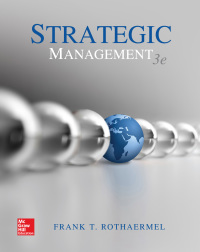Description
Test Bank For Strategic Management 3rd Edition
Chapter 05
Competitive Advantage, Firm Performance, and Business Models
Multiple Choice Questions
|
1. |
The three financial ratios that constitute return on revenue are Cost of goods sold/Revenue, Research & Development expense/Revenue, and A. Accounting profitability/Revenue. B. Economic value created/Revenue. C. Total return to shareholders/Revenue. D. Selling, general, & administrative expense/Revenue. |
|
2. |
_____ precisely indicates how much of a firm’s sales is converted into profits. A. Break-even price B. Working capital turnover C. Return on revenue D. Inventory turnover |
|
3. |
The ratio Cost of goods sold/Revenue indicates how efficiently a company can A. produce a good. B. sell a good. C. advertise a good. D. design a good. |
|
4. |
Apple Watch retailed for $349 in 2015, and the firm was predicted to sell millions of units. The firm’s total cost in terms of materials and labor for the Apple Watch was no more than $84. Thus, Apple’s profit for each watch sold is an estimated $265, with a profit margin of _____ percent. A. 215 B. 265 C. 315 D. 365 |
|
5. |
A high percentage of R&D/Revenue ratio indicates a(n) A. strong focus on innovation to improve current products and services. B. inefficiency in the management to focus on new products. C. strong focus on marketing and sales to promote products and services. D. negligent investment toward research and development. |
|
6. |
_____ is best described as a measure of how effectively capital is being used by a firm to generate revenue. A. Return on revenue B. Risk capital C. Working capital turnover D. Revenue per employee |
|
7. |
The working capital turnover of Tesva Systems Corp. is 6.0. What does this financial data suggest? A. For every $6.00 Tesva Systems puts to work, the company incurs a cost of $1.00. B. For every $6.00 Tesva Systems puts to work, the company realizes sales of $1.00. C. For every dollar Tesva Systems puts to work, the company realizes $6.00 in loss. D. For every dollar Tesva Systems puts to work, the company realizes $6.00 of sales. |
|
8. |
The working capital of a small home-based business is $200,000. The revenues generated account to $600,000, and the profits incurred are $300,000. What would be the company’s working capital turnover? A. 3, that is, $600,000/$200,000 B. $300,000, that is, $600,000 – $300,000 C. 2, that is, $600,000/$300,000 D. $100,000, that is, $300,000 – $200,000 |
|
9. |
_____ most precisely measures how well a company leverages its fixed assets, particularly property, plant, and equipment (PPE). A. Working capital turnover B. Fixed asset turnover C. Fixed assets to equity ratio D. Capital leverage ratio |
|
10. |
The fixed asset turnover of a company is 8.3. What do you infer from this? A. Every dollar spent on the company’s fixed assets generates $8.30 of revenue. B. 8.3% of the company’s revenue is invested in fixed assets. C. The return on fixed assets will break even in 8.3 years. D. The cost of capital invested on fixed assets is 8.3% of the total profit. |
|
11. |
Which of the following best expresses fixed asset turnover? A. Current assets/Fixed assets B. Revenue/Fixed assets C. Fixed assets/Total return to shareholders D. Fixed assets/Current liabilities |

Reviews
There are no reviews yet.